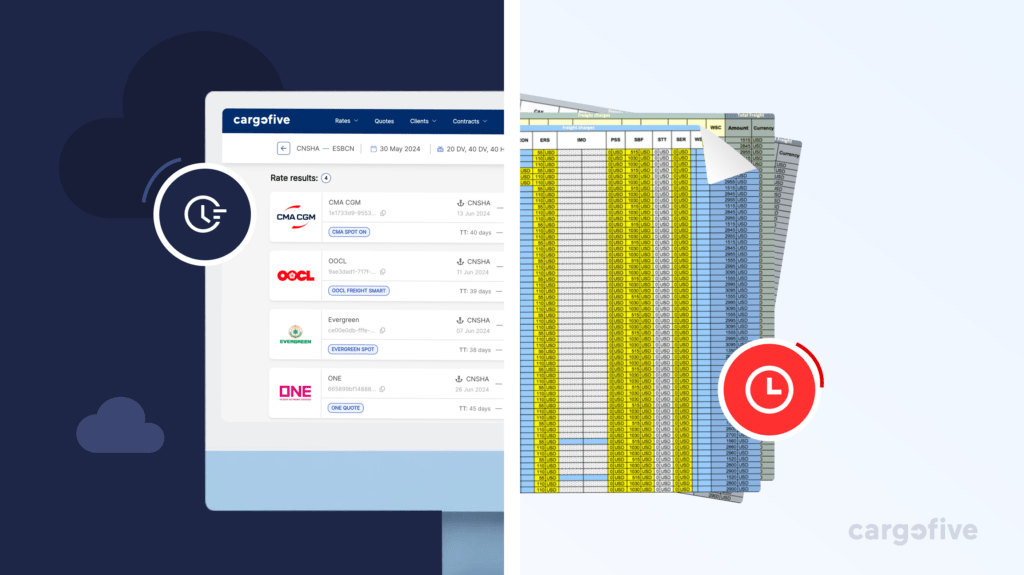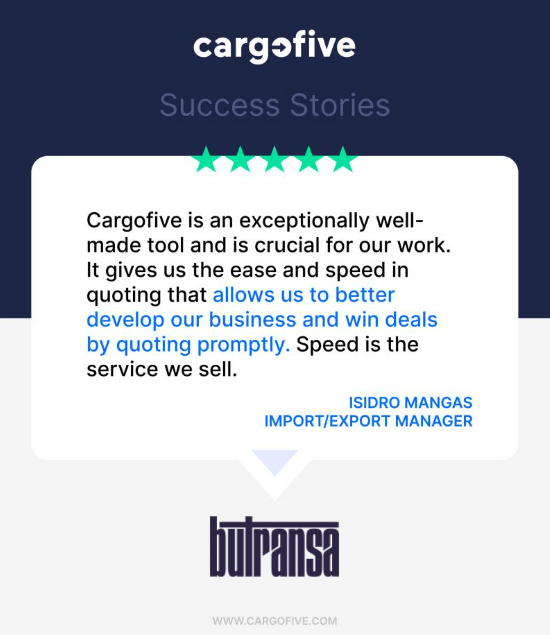
Manual freight rate management costs businesses millions annually due to errors, inefficiencies, and wasted time.
Digital systems solve these problems, offering faster processes, fewer mistakes, and long-term savings. Here’s what you need to know:
- Manual Challenges:
- 15% of carrier invoices contain errors.
- Sales teams lose 43% of their time on quotes.
- Up to 80% of companies overpay for freight.
- Digital Benefits:
- Automates tasks, reducing manual work by 80%.
- Cuts quoting time from 3 days to minutes.
- Minimizes errors and saves $700M annually across the industry.
Quick Comparison
| Factor | Manual | Digital |
|---|---|---|
| Initial Cost | Low | Higher upfront investment |
| Labor Costs | High | Reduced by 80% |
| Error Rate | 15% invoice errors | Minimal (automated checks) |
| Processing Time | Up to 3 days | Minutes |
| Scalability | Expensive with growth | Easily scalable |
| Long-Term ROI | Low | High |
Switching to digital rate management is a smart move for logistics companies looking to save time, reduce costs, and stay competitive.
Drawbacks of Manual Rate Management
Managing freight rates manually continues to weigh down logistics operations with inefficiencies and hidden costs. Studies show these outdated methods create financial strain on businesses in several ways.
Risk of Human Errors and Cost Implications
Errors in manual data entry, like mismatched rates or incorrect surcharges, are a recurring problem, costing businesses millions each year. These mistakes don’t just result in direct financial losses – they also disrupt broader operations.
“Manual freight contract management is labor-intensive and error-prone, leading to overpayments and misquotes.”
| Impact Area | Cost Driver | Consequence |
|---|---|---|
| Labor Utilization | Repetitive Data Entry | Higher overhead costs |
| Quote Accuracy | Manual Calculations | Revenue loss from underquoting |
| Response Time | Slow Processing | Missed business opportunities |
Time-Consuming Processes
Manual rate management slows down quoting processes by as much as three days and consumes 43% of sales executives’ time, limiting their ability to focus on strategic tasks. This lost time represents a significant opportunity cost, pulling skilled professionals away from activities that could help grow the business.
These inefficiencies ripple across the supply chain, leading to delayed responses, miscommunication, and even misplaced shipments. Without a centralized system, businesses face slower customer service and increased chances of errors.
Addressing these challenges is crucial. Companies that stick to manual processes risk falling behind competitors who have already transitioned to digital rate management solutions.
Benefits of Digital Rate Management
Switching from manual to digital rate management systems can solve inefficiencies while boosting productivity and cutting costs. Recent industry insights highlight how these systems can transform operations.
Automation and Time Efficiency
Digital systems speed up quote generation by offering real-time spot pricing and booking options. This makes processes faster and more efficient – especially for forwarders juggling both fixed and dynamic pricing needs. Sales teams, for instance, can shift their energy from preparing quotes to focusing on strategic tasks .
“Digital systems provide real-time spot pricing and booking options, which are increasingly critical for forwarders to manage both static and real-time aspects of their business”
Cargofive’s Freight Rate Management Software is a prime example of how digital tools can handle multiple rate requests at once, eliminating traditional bottlenecks.
Accuracy and Error Reduction
Manual processes often lead to mistakes, with carrier invoices showing a 15% error rate. Digital platforms tackle this issue with automated validation and centralized data, which significantly cuts down errors.
| Error Type | Impact | How Digital Systems Help |
|---|---|---|
| Invoice Errors | 15% of carrier invoices have mistakes | Automated validation and verification |
| Service Overcharges | 80% of companies overpay for freight | Real-time rate monitoring |
| Annual Industry Loss | $700 million lost to invoicing errors | Centralized error prevention |
By serving as a single source of truth, these platforms reduce discrepancies and ensure accurate calculations.
Scalability and Flexibility
Digital rate management platforms are designed to adapt to evolving business demands. This adaptability becomes especially useful during peak seasons or when entering new markets.
Some standout features include:
- Real-Time Updates: Instantly adjust rates to match market changes.
- Integration Capabilities: Easily connect with existing transportation management systems.
- Customizable Options: Tailor features to fit specific operational needs.
These systems can handle growing volumes of rate data without sacrificing accuracy. This means businesses can expand without needing to significantly increase resources or staff [6].
The improvements in efficiency, accuracy, and scalability not only streamline daily operations but also lead to noticeable cost savings – something we’ll delve into further in the next section.

Cost Analysis: Digital vs Manual
Initial Costs vs Long-Term Savings
Switching from manual to digital rate management comes with upfront costs, but the payoff is worth it. Investing in digital systems – like software and implementation – yields a fast return by cutting inefficiencies. For example, digital tools slash quote and pricing handling time by 43%, freeing up sales teams to concentrate on bringing in revenue rather than getting bogged down by admin tasks.
These time and labor savings translate into broader operational benefits, as we’ll break down further.
Efficiency and Labor Cost Savings
Digital systems take over routine tasks, cutting manual work by as much as 80%. This automation leads to noticeable reductions in labor costs, while allowing teams to focus on higher-value activities that help the business grow.
Errors in invoices also take a toll – about $700 million is lost every year due to inaccuracies.
Digital systems help recover much of this by minimizing mistakes, making them a smart move for companies looking to save both time and money.
| Cost Factor | Digital Management | Manual Management |
|---|---|---|
| Initial Investment | Higher upfront software costs | Lower initial costs |
| Labor Expenses | 80% reduction in manual task time | High ongoing labor costs |
| Error-Related Costs | Minimal – automated validation | Up to 15% invoice error rate |
| Processing Time | Minutes for quote generation | Up to 3 days for rate processing |
| Scalability Cost | Minimal additional expense | High with volume growth |
| Long-Term ROI | High – through automation and accuracy | Low – ongoing operational costs |
This table makes it clear: digital systems justify their upfront costs.
They deliver faster processes, fewer errors, and lower long-term expenses, making them a smart choice for companies aiming to streamline rate management.
Digital Freight Rate Management Tools
Digital tools simplify the complexities of freight pricing, cutting down errors and boosting efficiency. Platforms like Cargofive demonstrate how technology can outperform manual methods in both cost and accuracy.
Cargofive connects with over 25 shipping lines, automates rate processing, centralizes contract management, and integrates seamlessly with ERP and TMS systems. It handles SPOT, FAK, and NAC rates in real-time, making it a go-to solution for freight forwarders looking to streamline operations.
Cargofive Benefits
The platform’s advanced contract processing engine offers real-time insights and resolves the pricing inefficiencies often seen in manual systems.
| Operational Area | Digital Benefit | Business Impact |
|---|---|---|
| Rate Processing | Automated contract handling | Cuts processing time from days to minutes |
| Data Accuracy | Centralized rate database | Reduces pricing errors and disputes |
| System Integration | ERP/TMS connectivity | Simplifies workflows across platforms |
| Management Control | Real-time visibility | Improves oversight and decision-making |
Cargofive speeds up quote generation to just minutes while ensuring precision through automated checks. Its tailored features give freight forwarders an edge by enabling quicker responses and minimizing errors.
Platforms like Cargofive highlight how digital rate management tools can transform operations, helping businesses stay competitive in a fast-paced industry.
Conclusion
The move from manual to digital rate management marks a major shift in the logistics industry. Manual processes often lead to delays and financial losses, making digital tools an increasingly smart choice.
Digital rate management systems bring faster processing, fewer mistakes, and the ability to scale operations. These tools can cut processing times from days to just minutes while significantly reducing costs tied to errors.
Business Benefits of Digital Solutions
| Area of Focus | Digital Solution Impact | Business Advantage |
|---|---|---|
| Operational Costs | Reduces manual workload | Lower labor expenses |
| Error Reduction | Automated checks | Savings through accuracy |
| Growth Opportunities | Scalable infrastructure | Prepared for future demands |
The data makes it clear: manual rate management comes with hidden costs, while digital tools offer a way to boost profitability and support sustainable growth.
As the logistics sector continues to change, companies adopting digital rate management tools gain a strong edge in a competitive market.
Though digital tools require an upfront investment, the long-term savings far outweigh the initial costs.
These solutions not only address inefficiencies but also enable businesses to expand and adapt with ease.
“Managing change is difficult and because of that many keep with the old way of doing things. If you are still feeling undecided, here is why it is in the best interest of your organization to say goodbye to manual rate management.”
For logistics professionals, switching to digital rate management isn’t just about keeping up with the times – it’s a smart investment in accuracy, efficiency, and cost savings that ensures a lasting competitive edge.
AUTHOR



